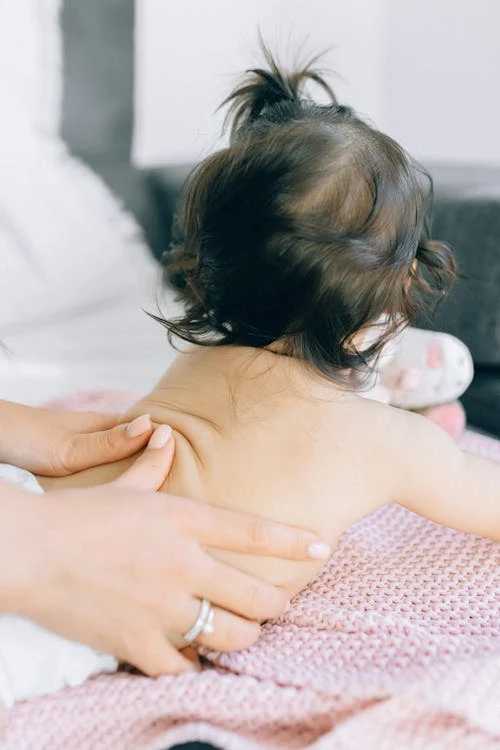Are you looking for ways to relax your little one? Try a baby massage! This routine consists of gently rubbing and stroking the body’s muscles. It helps to calm them, enhance their sleep patterns, and decrease pain from colic or gas. All parents can learn and use it, turning routine care into profound intimacy and serenity moments. Consistency in massaging babies enables them to feel love and safety, thus laying a good foundation for emotional and physical growth. Therefore, this guide will analyze how baby massage can become one of the necessary tools that will support that special relationship between you and your child.
Introduction to Baby Massage
Table of Contents
Understanding what touch means in early childhood development is vital because baby massage allows us to utilize this power directly. Touch is the first sense human beings develop, which helps them gain confidence and feel safe with those who care for them when they are young. Parents can communicate love, security, and care towards their infants through purposeful strokes coupled with gentle pressure during massages, fostering a deeper emotional connection.
Moreover, it does not only help establish bonds between parent and child on an emotional level but also has various physical health benefits, including regulation of the digestion system among infants as well as prevention or relief of typical digestive troubles like colic or gas; hence, it is suitable for infants suffering from restlessness due to stomach upsets, thereby helping parents get more sleep at night.
Preparing for Baby Massage

Planning for a baby massage should be done before the actual activity so that it may be peaceful for both the mother and her child. It would be best if you had calming surroundings. Find somewhere warm and quiet where they can feel cozy enough to sleep. Soft lighting and gentle music will also help in creating a soothing atmosphere.
The best time is usually after a bath or before bed as part of a calming nighttime routine. Ensure the room is warm enough for your baby to be undressed comfortably, and select a flat, safe surface like a changing table or bed with soft towels for support.
Basic Techniques
The beginning of a baby massage should be done gently to give the child comfort and security. Take some time to rub your hands together to warm them, and start with gentle strokes on their legs or arms. Such initial contact helps your little one get used to being massaged.
Slowly stroke your baby’s skin, watching how they respond. This will help you establish what they like or find soothing. Important among baby massages are long, smooth strokes and easy kneading that can be done through the chest, back, arms, and legs towards the heart to enhance blood flow. This area can be gently massaged clockwise using circular movements for digestion purposes.
Recognizing Baby’s Cues and Responsiveness to Massage
Baby massage for bonding creates an extraordinary emotional connection between mother (or father) and child, which is different from other caring ways available traditionally today. Parents who practice this mode of communication interpret non-verbal signs that their children display during massages, leading to a better understanding of their infants’ needs/preferences through tactile communication.
Crossing the bridge between body language and babies’ giggles, coos, or relaxed faces while you rub them indicates enjoyment and vividly promotes attachment. In the same way, learning about the baby’s boundaries helps parents identify signs of distress, ensuring feelings of discomfort are avoided. This eventually builds respectful, healthy interactions, reducing stress-related conditions like colic in infants.
Physical Benefits

Baby massage has physical benefits that significantly contribute to a child’s overall development and good health. Massages done regularly by parents improve sleep in babies quite considerably. This is achieved through soothing strokes that massage provides, promoting more restful sleep.
Additionally, gentle belly rubs can help with digestion problems and alleviate colic symptoms, giving a happier child who is never stressed out about tummy issues. Moreover, infant massages have long-term benefits for the overall development of the body. Massage tactile stimulation enhances body awareness while simultaneously stimulating the circulatory and digestive systems, supporting healthy growth.
Emotional and Cognitive Benefits
Baby massage has profound cognitive and emotional impacts. For instance, it contributes to a strong bond between baby and parent, promoting safety, comfort, and trust. Hence, these first encounters of connection and security are the foundations of future emotional well-being, including self-esteem development and well-being relationships.
Another issue is the brain development aspect of touch during massage, which is related to what happens when different forms of stimulation are employed. Such sensory experiences open up neural pathways, making learning, attention, and memory processes possible. Thus, baby massage has more than just physical benefits; it is also necessary for a child’s emotional and cognitive well-being, leading to overall well-being.
Adjusting Yout Routine

Your daily routines can be moments of bonding with your baby through massaging, thereby promoting their growth and comfort. To ensure this experience is nurturing, you must make it a relaxing custom for both you as a mom or dad and the baby. Find an easy time when you can do it without interruptions. This will signal your baby that this is sleep time for them; therefore, you should do it in the evening hours, a bath, or before bedtime to easily integrate it into your existing routine.
As babies grow older, their needs change, necessitating changes in how you approach messages to them. Stay alert to differences in gestures shown by your child during massages because they indicate what new techniques would work better or worse on them as they grow up from infancy through early childhood towards adulthood.
FAQs
How soon can I start doing massages on my child?
You shall commence applying light strokes on your infant approximately two weeks after birth, though you must ensure both are ready for this bonding experience. Look for a calm time when your baby is alert but not overly hungry or full.
Can massage help with digestion in babies?
A gentle tummy rub and other parts of the belly can improve digestion and relieve babies of common issues like gasses, colic, and constipation by aiding movement within their gastrointestinal tracts.
How long should a baby massage last?
A baby’s age and response determine how long a massage will take, varying from a few minutes to twenty minutes. Therefore, you must watch for contentment or fussiness signs to judge the most suitable time frame.
Should I use oil for massaging my infant?
Although it isn’t compulsory, applying some plain, non-scented oil can enhance smoothness on his body surface while making the activity enjoyable for both parties. However, test any new oils on a small section of your child’s skin to ascertain that no allergic reactions occur before all else.
Add it to Your Routine

This guide has helped explain the significance and gains of baby massage. When you include it in your routine, the baby will develop physically, emotionally, and cognitively, strengthening their relationship with you. It is essential to appreciate that it not only involves a set of instructions but also shows love and an obligation to the child’s well-being. Let your massage time be about connection and growth for you and your little one. Cheers to the numerous advantages this simple yet profound act can offer early in life, laying the basis for healthiness, joy, and closeness.


